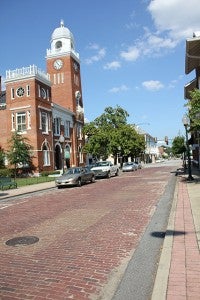City, DDA aim to expose brick streets in downtown Bainbridge
Published 6:42 pm Friday, August 14, 2015

The DDA wants to expose more of the brick streets beneath the asphalt in Downtown Bainbridge and also remove the asphalt “lip between the brick section of Water Street and the curb.
Somewhere at the intersection of Shotwell and Broad Streets, below the layers of asphalt, is a brick that reads “J. W. Callahan, Mayor 1912.”
On Aug. 5 1912, former Bainbridge mayor J. W. Callahan laid the first brick in the city’s “March of Progress” initiative, according to an Aug. 9, 1912 edition of the Bainbridge Search Light.
“Mayor Callahan, not being an expert brick layer, was coached by the men who have the work in charge,” the article reads.
It further details how quickly the brick was put down, with workers laying as many as 40,000 bricks a day to finish the roughly 25,000 square yards of road (or 225,000 square feet). It was estimated to take about one million bricks to complete the project that, when completed, would allow Bainbridge to “boast of some of the prettiest streets of any city in the South,” according to the article.
Now, more than 100 years later, exposing the brick is on the Downtown Development Authority’s list of action items for 2015.
DDA executive director Amanda Glover isn’t sure if the process will get started in 2015, but doesn’t plan to give up on it any time soon.
Glover said that removing the asphalt from the bricks had proven to be a simple process when city workers scraped the block of Water Street in front of the Decatur County Courthouse, and the asphalt just “popped up.”
“It’s getting [the project] worked into the schedule with public works,” Glover said. “It’s very doable for our city workers, and we’ve done our research.”
Glover said that she, public works director Steven Winburn and DDA chairman Al Collins visited Thomasville and spoke with city representatives on its ongoing brick exposure work.
“Some people don’t like it because they say it’s bumpy, but people fly through downtown where there’s some pedestrian traffic,” Glover said. “It adds the charm back to downtown.”
Glover said that her dream would be to expose all of the brick, but that her focus is in the core of downtown, with first removing the asphalt lip between the brick and curb on the exposed Water Street block. Another part high on the to-do list is making the transition from brick to asphalt smoother at the intersection of Water and West Streets.
“I would love to see every brick exposed, but I know that’s a big goal,” Glover said.
Glover said that the DDA has contacted a brick company that projected as much as 30 percent of the bricks in the downtown area could need replacing, which would come from the DDA’s budget. The DDA has no way of knowing how many bricks need replacing without removing the asphalt.
Another roadblock is Broad Street’s status as a state route, which the city is talking about trying to change.
“If or when we get the trucks rerouted, Broad will be a challenge,” Glover said, “because, there are some humps that represent years and years of repaving.”





